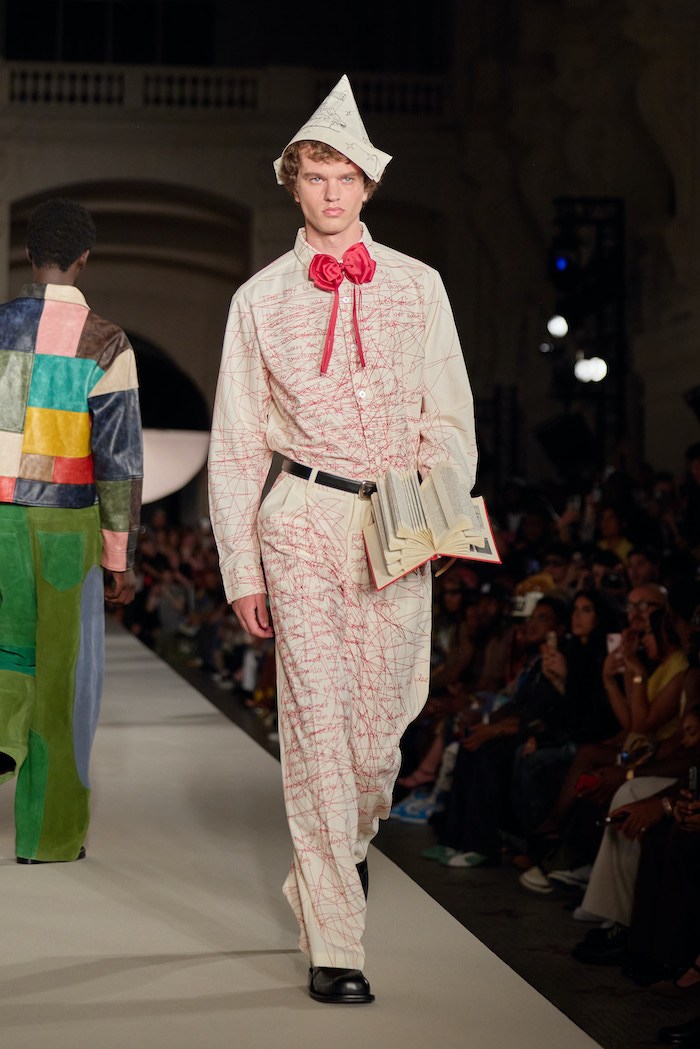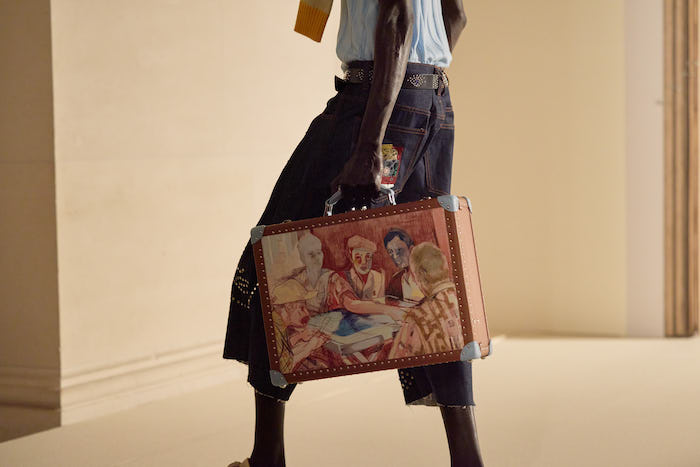 |
| Brilliant colour and natural materials were key to Imane Ayissi's new collection in Paris. Photograph (above) and cover picture by Andrea Heinsohn for DAM. |
 |
A brilliant fuchsia and raffia flowers made this gown a highlight of the collection. Photograph: Andrea Heinsohn |
“My couture is made to dress women, but a collection is also a way of telling stories, of expressing my vision,” the designer said. “This season, I wanted to talk about nature, and the way contemporary humanity mistreats it. That’s why this collection is called Ikorrok. It sums up the new relationship we should all be entering into with nature today.”
In an industry known for excess, Ayissi presented a collection that sought to realign couture with responsibility. Materials were chosen not merely for their beauty but for their ability to one day return to the earth.
French sheep’s wool felt formed the base of jackets and gowns, their rough-edged seams reminding the audience of natural textures rather than manufactured polish. These were embroidered with porcelain flowers, semi-precious stones, and Japanese urushi lacquer, developed in collaboration with visual artist Aline Putot-Toupry, bringing the tactile richness of craft into conversation with sustainability.
"A collection is also a way of telling stories, of expressing my vision. This season, I wanted to talk about nature, and the way contemporary humanity mistreats it"
 |
Leaves and flowers in fabric made this sculptural dress. Photograph: Jay Zoo |
If the philosophy was cerebral, the clothes themselves were anything but austere. Ayissi is a master of color and silhouette, and Ikorrok unfolded like a living garden, teeming with vitality. Silks, hand-dyed cottons, raffia, and felt appeared in hues as bright as tropical flora: vermillion, fuchsia, emerald, and cobalt. The designs mixed the sharp and architectural with the soft and draped, echoing the organic tension between geometry and growth.
"This collection is also a stylistic exercise in the different ways fashion can evoke nature, both flora and fauna," Ayissi ecplained."Visually, with prints, brocades, embroidery, appliqués and ornamentation, such as the beading of small animals, a technique inspired by traditional Yoruba culture. But also in a more abstract way, by creating garments that are “gentle” on nature, entirely bio-degradable for example, like these garments in French sheep's wool felt.''
Flowers were the most consistent motif, explored with both subtlety and theatricality. One of the show’s most memorable looks transformed the model’s torso into an explosion of vermillion petals, sculpted outward in a dynamic silhouette that blurred the line between garment and sculpture. Elsewhere, delicate white porcelain blooms dotted a tailored pink jacket, balancing softness with structure.
If the philosophy was cerebral, the clothes themselves were anything but austere. Ayissi is a master of color and silhouette, and the collection unfolded like a living garden, teeming with vitality
 |
A tie-died jumpsuit with beaded details that move with the wearer. Photograph: Jay Zoo |
In one striking ensemble, a tie-dyed jumpsuit with a defined waist shimmered with beaded fringes, the glistening details in constant motion under the lights (see at left).
Part of the show’s strength lay in its contrasts. Ayissi paired structured jackets with fluid drapery and oversized felt discs as earrings with refined silk slips, creating a dialogue between restraint and exuberance. Gloves, elbow-length and rendered in a kaleidoscope of colors, completed many looks, reinforcing his flair for styling that feels both unexpected and deliberate.
This play of opposites extended beyond form and into cultural dialogue. Ayissi, born in Cameroon and long based in Paris, has consistently worked to weave African craft traditions into the language of haute couture. Raffia, a material he has made central to his practice, reappeared this season, elevated through his meticulous handling.
Ayissi, born in Cameroon and long based in Paris, has consistently worked to weave African craft traditions into the language of haute couture.
 |
A dramatic, asymmetrical design in orange with raffia fringes. Photograph: Jay Zoo |
What emerged from this collection was not simply an ode to nature but a layered meditation on heritage and modernity. The garments felt alive with cultural memory, Yoruba beading, the Ewondo language, raffia traditions, yet were resolved through the lens of Parisian couture technique.
The tension between these elements created a powerful synergy, reminding the audience that couture is at its best when it is not static but evolving, absorbing influences, and reshaping traditions.
The show was not without its moments of theatrical flourish with large, floral constructions and embellished gowns. The clarity of Ayissi’s vision was apparent in his strongest pieces, where sharp tailoring was softened by delicate ornament or where natural textures were elevated to elegance, which felt both fresh and intentional.
The garments felt alive with cultural memory, Yoruba beading, the Ewondo language, raffia traditions, yet were resolved through the lens of Parisian couture technique
 |
A richly tie-died design warm colours. Photograph: Jay Zoo |
Fallow ground is not wasted ground; it is ground in waiting, a place of renewal. His collection suggested that couture, too, can pause from its cycles of spectacle and reinvention to reflect, regenerate, and grow in a different way.
Once again, Ayissi made a compelling case for the presence of African craft in the heart of Paris couture, not as a novelty but as a vital force reshaping the language of luxury. The new collection was a reminder that beauty and responsibility, heritage and innovation, can sit side by side. In the sunlit salons, as the last model left the runway, it was difficult not to feel that Ayissi had done more than present a collection. He had planted a seed for a new fashion direction.
Scroll down to see more highlights from Imane Ayissi's AW25/26 collection in Paris
 |
| Imane Ayissi, Ikorrok, Autumn -Winter 2025/2026. Paris Haute Couture. Photograph: Jay Zoo |
 |
| Imane Ayissi, Ikorrok, Autumn -Winter 2025/2026, Paris Haute Couture. Photograph: Jay Zoo |
 |
| Imane Ayissi, Ikorrok, Autumn -Winter 2025/2026, Paris Haute Couture. Photograph: Andrea Heinsohn |
 |
| Imane Ayissi, Ikorrok, Autumn -Winter 2025/2026, Paris Haute Couture. Photograph: Jay Zoo |
 |
| Imane Ayissi, Ikorrok, Autumn-Winter 2025/2026, Paris Haute Couture. Photograph: Andrea Heinsohn |
 |
| Imane Ayissi, Ikorrok, Autumn-Winter 2025/2026. Paris Haute Couture. Photograph Jay Zoo |
 |
| Imane Ayissi, Ikorrok, Autumn-Winter 2025/2026. Paris Haute Couture. Photograph: Andrea Heinsohn |
 |
| Imane Ayissi,Ikorrok, Autumn-Winter 2025/2026, Paris Haute Couture. Photograph Jay Zoo |
 |
| Imane Ayissi,Ikorrok, Autumn-Winter 2025/2026, Paris Haute Couture. Photograph Andrea Heinsohn |
 |
| Imane Ayissi,Ikorrok, Autumn-Winter 2025/2026, Paris Haute Couture. Photograph Jay Zoo |
 |
| Imane Ayissi,Ikorrok, Autumn-Winter 2025/2026, Paris Haute Couture. Photograph Andrea Heinsohn |
 |
| Imane Ayissi,Ikorrok, Autumn-Winter 2025/2026, Paris Haute Couture. Photograph Jay Zoo |
 |
| Imane Ayissi,Ikorrok, Autumn-Winter 2025/2026, Paris Haute Couture. Photograph Andrea Heinsohn |
 |
| Imane Ayissi,Ikorrok, Autumn-Winter 2025/2026, Paris Haute Couture. Photograph Andrea Heinsohn |
 |
| Imane Ayissi,Ikorrok, Autumn-Winter 2025/2026, Paris Haute Couture. Photograph Jay Zoo |
 |
| Imane Ayissi,Ikorrok, Autumn-Winter 2025/2026, Paris Haute Couture. Photograph Jay Zoo |
 |
| Imane Ayissi,Ikorrok, Autumn-Winter 2025/2026, Paris Haute Couture. Photograph Jay Zoo |
 |
| Imane Ayissi,Ikorrok, Autumn-Winter 2025/2026, Paris Haute Couture. Photograph Andrea Heinsohn |
 |
| Imane Ayissi,Ikorrok, Autumn-Winter 2025/2026, Paris Haute Couture. Photograph Andrea Heinsohn |















































